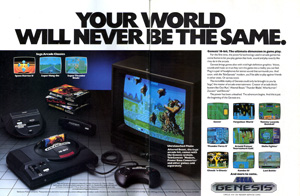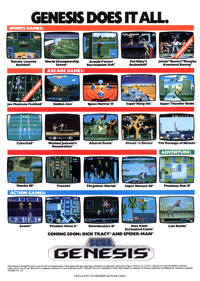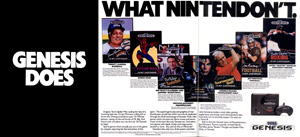

|
1989-1990
"The technology has reached the point... where we've run up against the limitations of the TV set in terms of the image it is capable of producing."
- A Sega "technical support person", VG&CE July 1990

|
|
The ad that started it all...
|
Altered Beast
Sega
4 megabitsBased on the Sega arcade game of the same name, Altered Beast was the "pack-in" game included with the Genesis system until it was replaced by Sonic The Hedgehog in the latter half of 1991. I've always considered the choice to include Altered Beast a wise one, not least as it served to showcase many of the Genesis system's advantages over the competing consoles of the day. The layers of parallax scrolling aside, Altered Beast is perhaps best remembered for its liberal use of digitised speech. Phrases such as "rise from your grave" and "welcome to your doom" have long since entered into the average gamer's vernacular, even among those who never actually owned the game. The stereo music was also incredible for the time, featuring catchy tunes with crystal clear percussion and thunderous bass. I also think it was a good idea to include Altered Beast with the Genesis system because, weighing in at a mere five stages of play, it wasn't a terribly deep or varied game. Purchased on its own for full retail price, Altered Beast would almost certainly have been a disappointment, especially compared to other quality Genesis titles such as Ghouls 'n Ghosts. Packed in with the Genesis system, however, Altered Beast was able shine for what it was: a short but entertaining experience. "The Genesis version of Altered Beast, packaged with each Genesis system, is virtually identical to the arcade game."
- Matthew A. Firme, Game Player's Sega Genesis Strategy Guide Fall 1990
|

|
|
Sega took every opportunity to remind you just how many games were available for the Genesis. This is the first version of the "Genesis Does It All" ad.
|
Super Thunder Blade
Sega
4 megabitsAnother early arcade-to-Genesis conversion, Super Thunder Blade probably would have fared better if the developers had been able to use a larger cartridge ROM. Unfortunately, as this game was released in Japan in 1988, a larger cartridge would likely have been prohibitively expensive to produce. What we are left with is a somewhat choppy looking third-person helicopter shooter. Although there are only four different stages, each one looks significantly different from the others and manages to maintain the player's interest. Indeed, the even numbered stages feature stalactites and pillars which require skillful maneuvering to avoid. The game's "boss encounters" are particularly impressive, as the player's perspective changes from behind the helicopter to above the helicopter on the fly! The smoothly scaling letters on the high-score table are also worthy of note; it's a shame the entire game couldn't have been that smooth... Typical of Sega's games in the early years of the Genesis, Super Thunder Blade features a fantastic soundtrack (in this case by composer Sting Saito). The music helps to create a different mood for each stage, often in stark contrast to the stage that came before. For example, stage one's pumping technopop tune eventually gives way to stage two's melancholy and almost depressing track. Despite its shortcomings as an arcade conversion, I have fond memories of Super Thunder Blade, and I hope that Sega will one day see fit to update the series for a modern audience. Barring that, an arcade-perfect conversion as part of the "Sega Ages" series for the PlayStation 2 would at least finally give this game the respect it deserves! "A Genesis feature that has no Amiga hardware equivalent is "sprite scaling." This allows for rapidly and accurately changing the size of sprites, an essential feature in 3-D perspective games such as Thunder Blade, Galaxy Force and Space Harrier."
- Frank Eva, VG&CE August 1990
"The first-person perspective and 3-D feel of Super Thunder Blade give the game an urgent quality that makes it stand out from the crowd."
- Buyer's Guide, Game Player's Sega Genesis Strategy Guide Fall 1990
|

|
|
"Zoom!" looks a lot like Phantasy Star II in this ad...
|
Space Harrier II
Sega
4 megabitsOne of my favourite Genesis games, Space Harrier II is a sequel of sorts to the famed arcade game of the mid-eighties. I have always admired the different approach Space Harrier II's artists took when designing the game's graphics. Instead of simply imitating the style of the arcade version, they gave Space Harrier II a more "mature" look. Harrier himself appears to be taller and less cartoon-like than he was in the original, and the enemy creatures he faces throughout this adventure are strangely frightening and beautiful at the same time. Space Harrier II features music by the mysterious Bo, who also created the score for Phantasy Star II. It appears that Bo was the pseudonym of one Tokuhiko Uwabo, and the rousing "Harrier Saga" theme is an excellent example of the man's musical genius. As such, I can't help but wish I knew more about who he was and what he's doing now. It's a shame really, because all of Bo's soundtracks were spectacular, and the music of Space Harrier II is no exception! "Space Harrier II is a standard arcade-action game, but it's an improvement over its predecessor. This game has better graphics, stereo music, and amazing sound effects."
- Buyer's Guide, Game Player's Sega Genesis Strategy Guide Fall 1990
|
Thunder Force II
Sega / Technosoft
4 megabitsThis shooter was quite unique, in that it boasted both traditional horizontally scrolling action as well as omnidirectional top-down stages. That being said, I always found the top-down stages in Thunder Force II to be incredibly frustrating and disorienting, and I was glad to see them go in what I consider to be this game's vastly superior Genesis sequel. Of special note is the digitised speech in Thunder Force II, as it is nearly incomprehensible and therefore highly amusing to listen to! "Thunder Force II proves that the superior graphics of the Genesis system can revitalize even the most familiar kinds of games."
- Buyer's Guide, Game Player's Sega Genesis Strategy Guide Fall 1990
|
Last Battle
Sega
4 megabitsLast Battle had some nice music. And... uh, large sprites. That pretty much sums up its good points... Unfortunately, Last Battle is a poorly conceived and badly executed mess. For starters, the enormous sprites look like cardboard cutouts sliding against a multilayered backdrop due to their lacklustre animation. I don't know if the way your enemies fly off the screen at MACH-3 at even the slightest flick of your wrist was intended to be funny, but play this game for more than a few minutes and much hilarity will ensue. After the hilarity comes the frustration, as you soon realise that Last Battle has its difficulty level set firmly on "impossible", and even the "cheat code" which allows unlimited continues won't help you much at all. Of course, excessive difficulty could perhaps be forgiven if the game provided a varied and innovative play experience, but Last Battle provides nothing but the endless monotony of punching and kicking wave after wave of uninspired opponents. Last Battle was definitely not one of the best Genesis launch titles but, thankfully, better games were on the way... UPDATE: Readers have pointed out that Last Battle was based on the Fist of the North Star franchise and released under that title in Japan. In the Japanese version of the game, enemies reportedly burst into bloody pieces when destroyed as opposed to just flying off the screen completely. It is doubful that these differences made the import version of Last Battle any less crappy of a game, though... "Last Battle takes full advantage of the Genesis graphic capabilities."
- Buyer's Guide, Game Player's Sega Genesis Strategy Guide Fall 1990
|

|
|
Baseball, Spiderman, Michael Jackson: Together once more at last!
|
Tommy Lasorda Baseball
Sega
4 megabitsThe first Genesis baseball game, Tommy Lasorda Baseball was very well received by the gaming press. This game no doubt helped establish the Genesis in its early days as the system of choice for sports fans, even before the arrival of EA Sports! "The finest available action-strategy baseball game on any system. Great graphics and sound (including incredible digitized speech), multiple viewpoints and strategic options make it an instant classic."
- Bill Kunkel & Arnie Katz, VG&CE July 1990
|
World Championship Soccer
Sega
4 megabitsThis was the first Genesis soccer game, and along with Tommy Lasorda Baseball and Arnold Palmer Tournament Golf formed the console's early sports lineup. "The graphics, while not astounding, are effective. The close-ups provided on corner kicks and other special plays are excellent."
- Buyer's Guide, Game Player's Sega Genesis Strategy Guide Fall 1990
|
Arnold Palmer Tournament Golf
Sega
4 megabitsI remember seeing a picture of Arnold Palmer Tournament Golf in a game catalogue when the Genesis system was released in 1989 and being struck by the detail that was apparent in the graphics. They were so detailed, in fact, that you could actually make out the wrinkles in the golfers' clothing! In the days of low resolution 8-bit systems, that sort of thing was really impressive! Although I never did purchase Arnold Palmer Tournament Golf, it helped to convince me that, graphically speaking at least, the Genesis system was definitely a cut above anything else available at the time. "Arnold Palmer Golf is an excellent simulation that's loaded with more options than a luxury sedan. Yet it's easy to learn and very enjoyable."
- "The Hot 100", Game Player's May 1990
|

|
|
Hollo Fighter ?
|
Super Hydlide
Seismic
4 megabitsIn the early days of the Genesis, RPGs were rather hard to come by. Seismic, one of Sega's first licensees, decided to help fill this gap in the system's library with their release of Super Hydlide. Unfortunately, although Super Hydlide is the sequel to a game for the Nintendo Entertainment System, its visuals demonstrate little improvement over its 8-bit progenitor. Player and enemy sprites are small and indistinct, which makes the game all the more frustrating to play because if the player accidentally kills some of the "good" creatures in the game it can have a negative impact on his reputation.
Speaking of frustrating play elements, one of the more irritating aspects of Super Hydlide lies in its "weight" system. If players find themselves carrying around too many weapons or items, the lead character will start to move more and more slowly, making it difficult to get back to a city in time to rest (a demand of the game's equally maddening day/night cycle). I suppose these elements were added to make the game more realistic, but in this case I think realism gets in the way of enjoyment.
Negative points aside, however, one must give credit where it's due: Super Hydlide has a great soundtrack. In addition to outstanding composition and sound quality, the game's music is especially notable for its uniqueness. With its subtle blend of echoing electronics and what sounds like someone strumming a guitar, the music of Super Hydlide is extremely memorable and fun to listen to.
"Despite the nice touches, this game will provide you with 40-80 hours of nonstop squinting."
- Joshua Mandel, VG&CE July 1990
|
"Even though there's sure to be hot titles on both systems, Sega appears to have an edge over the Turbo with a machine that is slightly more powerful - but powerful enough to make the difference."
- EGM Editorial Staff, Electronic Gaming Monthly #8
|
Previous | 1 | 2 | 3 | 4 | 5 | 6 | 7 | Next
|



